|
This, not Advent, is the true
Christmas Season. As most people in secular or Protestantized countries
are putting away "Christmas-y" things, and as shopping malls stop
blaring "Here Comes Santa Claus," Catholics are just getting started.
The cleaning and baking during penitential Advent pays off now, and the
feasting and caroling begin!
The entire Christmas Cycle is a crescendo of Christ's manifesting
Himself as God and King -- to the shepherds, to the Magi, at His
Baptism, to Simeon and the prophetess, Anna (Luke 2). The days from the
Feast of the Nativity
to the Epiphany are known as "The
Twelve Days of Christmas," with Christmas itself being the first day,
and Twelfthnight -- 5 January -- being the last of the twelve days.
Christmastide liturgically ends on 13 January, the Octave of
the Epiphany and the Baptism of Christ (at which time the season of
Time After Epiphany begins). But Christmas doesn't end spiritually
-- i.e., the celebration of the events of Christ's life as a child
don't end, and the great Christmas Cycle doesn't end -- until Candlemas on 2 February and
the beginning of the Season of Septuagesima.
In this way, just as From Ash Wednesday
on, we commemorate Christ in the desert for forty days, and just as
after Easter we celebrate for forty days until the Ascension, after Christmas we celebrate the Child Jesus for forty days --
all through the season of Time After Epiphany -- until Candlemas. The
schema of those Christ Child celebrations looks like this:
- Christmas
Christ is born
- Feast of the
Holy Innocents
Herod slaughters the baby boys in order to
kill the Christ Child
- The
Circumcision (the Octave of Christmas)
Jesus follows the Law
- Feast of the
Holy Name of Jesus
After He is circumcised, He is named and becomes a part of the Holy
Family
- Twelfth Night
The Twelve Days of Christmas as a Feast come to an end
- Feast of the
Epiphany
Jesus reveals His divinity to the three Magi, and during His
Baptism, and at the wedding at Cana
- Baptism of
Our Lord/Octave of the Epiphany
Christmas liturgically ends with the Octave of the Epiphany.
- Feast of the
Holy Family
Jesus condescends to be subject to His parents
- Feast of the
Purification (Candlemas)
40 days after giving birth, Mary goes to the Temple to be "purified"
and
to "redeem" Jesus per the Old Testament Law of the firstborn. Christmas
truly ends as a Season with Candlemas and
the beginning of Septuagesima.
Christmas Eve: S.
Maria Maggiore
Christmas Angel's Mass: S. Maria Maggiore
Christmas Shepherds' Mass: S. Anastasia
Christmas Kings' Mass: S. Maria Maggiore
St. Stephen: S. Stefano Rotondo
St. John: S. Maria Maggiore
Holy Innocents: S. Paolo fuori le mura
Circumcision: S. Maria in Trastevere
Epiphany: S. Pietro in Vaticano

The Symbols of Christmas
|
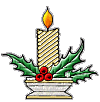
|
Light is the
pre-eminent symbol of Christmas. The Light Who is Christ was
foreshadowed by the Advent candles, and is now symbolized by the Christ
Candle that burns throughout the Twelve Days of Christmas. The Feasts
of the Epiphany and Candlemas celebrate Christ
as Light of the World in even more explicit ways. |
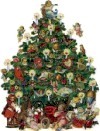 |
In the Middle
Ages, mystery plays were held on Christmas
Eve which featured a
Paradise Tree -- a tree representing both the Tree of the Knowledge of
Good and Evil and the Tree of Life from the Garden of Eden -- because
Christmas Eve was an unofficial "feast day" of Adam and Eve (it's their
official Feast Day in many Eastern Churches). The tree was decorated
with colorful apples representing the forbidden fruit, and with candies
representing the Tree of Life. These Mystery plays were suppressed
during the fifteenth century, but the faithful kept the "Paradise Tree"
tradition.
At another level of symbolism, Saint Boniface
(675-754) chopped down an
oak tree sacred to pagans at Fritzlar in Germany. He did this to show
them that nothing bad would happen, that Thor has no power. It is said
that when he did this, he pointed out a small fir tree growing at its
base and said "This humble tree's wood is used to build your homes: let
Christ be at the centre of your households. Its leaves remain evergreen
in the darkest days: let Christ be your constant light. Its boughs
reach out to embrace and its top points to heaven: let Christ be your
comfort and your guide." |
 |
Laurel, often
used in wreaths as in ancient Roman times, is a symbol of victory and
accomplishment, and came to be seen as a symbol of Christ's victory.
Laurel is often see, too, on tombstones, and is the root of the word
"laureate," meaning crowned with laurel, or accomplished. |
 |
In Roman times
wreaths (made of laurel) were used as symbols of victory. Christians
adopted the practice, using wreaths (usually of pine nowadays) to
represent the victory of the newborn King. Some families turn their
Advent wreaths into Christmas wreaths to be used starting on Christmas
morning. |
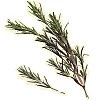 |
Rosemary is a
very, very old Christmas symbol. Legend has it that on the Flight to
Egypt after the Magis' visit and St. Joseph's dream, Our Lady washed
Baby Jesus' clothes out and laid them across some rosemary bushes to
dry. Since then, God blessed them with their lovely fragrance. |
|

|
Ivy was
originally banned for Christian use because of its pagan associations,
but after they were forgotten in the Middle Ages, ivy became seen as a
symbol for human reliance on divine strength because of the way it
clings to what it grows on. |
|

|
The prickly
leaves and red berries of holly (Ilex opaca) represent the Crown
of Thorns with Christ's Blood, a reminder to us that the Holy Infant
was born on this night only to redeem us with His Blood. Earlier
symbolism associates holly with the burning thorn bush that Moses saw. |
|

|
Mistletoe (Phoradendron
flavescens or Viscum album) is a poisonous parasite that
grows on hardwood trees and was considered "sacred" by the Druids and
Vikings. French tradition that holds that the reason mistletoe is
poisonous is because it was growing on a tree that was used to make the
Cross that Jesus was crucified on. Custom says that two people who find
themselves under a mistletoe plant must kiss, so mistletoe is often
hung over doorways or suspended from ceilings. In France, this custom
is reserved for New Years Eve. |
|

|
Poinsettia plants
(Euphorbia pulcherima), called "Nativity
Flower," and "Flores de Noche buena" or "Flowers of Holy Night" in
Mexico, is a New World Christmas tradition. The shape of the leaves
symbolize the Star of Bethlehem, their red color represents the Blood
of Christ and the burning love of God. A Mexican legend has it that a
poor girl wanted to give Baby Jesus something for His birthday but
could only present weeds to Him as that is all she had. As she laid
them near the Altar at church, they burst into beautiful red blooms.
To keep poinsettias fresh, don't overwater (before watering, remove
decorative wrap and let water drain thoroughly) and keep cool. |
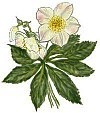 |
The Christmas
Rose (Helleborus niger) is a Christmas tradition that springs
from Germany. A legend surrounds it that is similar to that of the
poinsettia: a humble shepherdess felt that anything she gave to Baby
Jesus couldn't compare with what the Magi gave. As she sat weeping, an
angel came and swept the snow away from around her feet, and lovely
cup-shaped white blooms sprang up. The angel said to her, "Nor myrrh,
nor frankincense, nor gold is offering more meet for the Christ Child
than these pure Christmas Roses." This lovely flower can bloom all
Winter long. |
 |
In A.D. 63, St.
Joseph of Arimathea (John 19) and 11 companions were sent to England by
St. Philip the Apostle. Legend says that when he arrived at
Somersetshire, he thrust into the ground his staff which was made of
hawthorn (Crataegus Oxyacantha praecox), a plant from the Mediterranean
area. The Glastonbury Thorn sprouted from it -- a plant which has the
odd ability, in Somerset, to bloom around Eastertime and at Christmas.
The original plant was destroyed by Cromwell's Puritans (the soldier
who cut it down is said to have been blinded by a large splinter from
the tree), but many shoots had been taken from it and its progeny live
in Glastonbury to this day, heralding Christmas with its blossoms.
Since 1929, blossoms have been sent to grace the Queen's (or King's)
table on Christmas Day. |
 |
Rose of Jericho
(Anastatica hierochuntica and Selaginella lepidophy) survives in a
curled up, dormant, brown, dessicated state for years, and then opens
up and turns green with a bit of water. After returning to a lovely
green, it goes dormant again when its water source is removed. Because
of this fascinating property, it is often kept dormant in the home and
brought out at Christmas time to blossom and then close in order to
symbolize the opening and closing of Mary's womb. Read more about this
plant and see larger pictures of it in its dormant and verdant states here. |
|

|
The legend is
that in the late 1800's a candy maker in Indiana wanted to express the
holy meaning of Christmas through a symbol made of candy. He took white
peppermint sticks and bent them to suggest both the shepherd's staff
carried by the adoring shepherds, and the letter "J" for Jesus. He let
the color white symbolize the purity and sinless nature of Jesus, but
added the color red to represent His Blood. The three small stripes
symbolize the stripes of His scourging, and that there are three of
them represents the Holy Trinity; the bold stripe represents the Blood
Jesus shed for mankind. |
|

|
I don't know if
these birds are found in other parts of the world, but in North
America, cardinals have become a gorgeous symbol of Christmastide. If
you live in the right area and want to attract these sweet black-masked
songbirds to your yard, build a stationary (not a hanging) feeder with
a roomy tray about 5 or 6 feet off the ground and in or very close to
some bushes. Fill it up with some sunflower seeds, (the birds'
favorite) peanuts, safflower seeds, corn, raisins, dried apples, and/or
white proso millet. Have a filled bird bath nearby, heated if possible.
They will be most likely to come if you have both evergreen and
deciduous trees in your yard. Cardinals don't migrate, so will live
with you all year. Only the male has the shocking red color; his wife
has the same red beak and shape, but her body is olive-brown. To hear a
cardinal sing, click here. |
 |
The red-breasted
robin is another lovely symbol of Christmas. The story is told is that
Joseph built a fire in the manger to keep Mary and Jesus warm, but the
flames kept dying. A robin fanned them with its wings so that the fire
wouldn't die, and his proximity to the fire turned his breast red.
It's also said that a robin landed on the shoulder of Jesus as He
carried the Cross on Good Friday. When the bird plucked thorns from His
brow, the bird’s breast was stained forever with His Blood.
|
|

|
The Christmas carol (as opposed to the
formal Christmas hymn) is traceable to St. Francis of Assisi, who
organized different Nativity Mystery plays.
In between acts, carols
would be sung, and audience members would sing them in the streets,
too. For the 12 Days of Christmas, carols would be sung as party-goers
would move from one house to the next on their way to different
parties. Later, singers would gather just for the purpose of singing
door to door, usually to be rewarded with hot drinks and sweets. |
Reading
"The Mystery
of Christmas"
from Dom Gueranger's "The Liturgical Year"
Everything is
Mystery in this holy season. The Word of God, whose generation is
before the day-star, is born in time -- a Child is God -- a Virgin
becomes a Mother, and remains a Virgin -- things divine are commingled
with those that are human -- and the sublime, the ineffable antithesis,
expressed by the Beloved Disciple in those words of his Gospel, THE
WORD WAS MADE FLESH, is repeated in a thousand different ways in all
the prayers of the Church: -- and rightly, for it admirably embodies
the whole of the great portent which unites in one Person the nature of
Man and the nature of God.
The splendour of this Mystery dazzles the understanding, but it
inundates the heart with joy. It is the consummation of the designs of
God in time. It is the endless subject of admiration and wonder to the
Angels and Saints; nay, is the source and cause of their beatitude. Let
us see how the Church offers this Mystery to her children, veiled under
the symbolism of the liturgy.
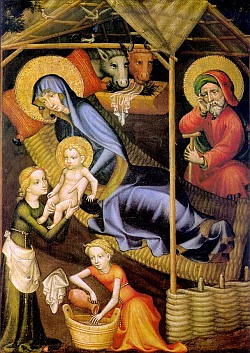
The four weeks of our preparation are over -- they were the image of
the four thousand years which preceded the great coming -- and we have
reached the twenty-fifth day of the month of December, as a long
desired place of sweetest rest. But why is it that the celebration of
our Saviour's Birth should be the perpetual privilege of this one fixed
day; whilst the whole liturgical Cycle has, every year, to be changed
and remodelled in order to yield to that ever-varying day which is to
be the feast of his Resurrection -- Easter Sunday?
The question is a very natural one, and we find it proposed and
answered as far back as the fourth century; and that, too, by St.
Augustine, in his celebrated Epistle to Januarius. The holy
Doctor offers this explanation: We solemnise the day of our Saviour's
Birth, in order that we may honour that Birth, which was for our
salvation; but the precise day of the week on which he was born, is
void of any mystical signification. Sunday, on the contrary,
the day of our Lord's Resurrection, is the day marked in the Creator's
designs, to express a mystery which was to be commemorated for all
ages. St. Isidore of Seville, and the ancient Interpreter of Sacred
Rites who, for a long time, was supposed to be the learned Alcuin, have
also adopted this explanation of the Bishop of Hippo; and our readers
may see their words interpreted by Durandus, in his Rationale.
These writers, then, observe that as, according to a sacred tradition,
the creation of man took place on a Friday, and our Saviour suffered
death also on a Friday for the redemption of man; that as, moreover,
the Resurrection of our Lord was on the third day after his death, that
is, on a Sunday, which is the day on which the Light was created, as
welearn from the Book of Genesis -- 'the two Solemnities of Jesus'
Passion and Resurrection,' says St. Augustine, 'do not only remind us
of those divine facts; but they moreover represent and signify some
other mysterious and holy thing.'
And yet we are not to suppose that because the Feast of Jesus' Birth is
not fixed to any particular day of the week, there is no mystery
expressed by its always being on the twenty-fifth of December. For
firstly we may observe, with the old Liturgists, that the Feast of
Christmas is kept by turns on each of the days of the week, that thus
its holiness may cleanse and rid them of the curse which Adam's sin had
put upon them. But secondly, the great mystery of the twenty-fifth of
December, being the Feast of our Saviour's Birth, has reference, not to
the division of time marked out by God Himself, but to the course of
that great Luminary which gives life to the world, because it gives
light and warmth. Jesus, our Saviour, the Light of the World, was born
when the night of idolatry and crime was at its darkest; and the day of
his Birth, the twenty-fifth of December, is that on which the material
sun begins to gain his ascendancy over the reign of gloomy night, and
show to the world his triumph of brightness.
In our Advent, we showed after the Holy Fathers, that the
diminution of physical light may be considered as emblematic of those
dismal times which preceded the Incarnation. We joined our prayers with
those of the people of the Old Testament; and with our holy mother the
Church we cried out to the Divine Orient, the Sun of Justice, that he
would deign to come and deliver us from the twofold death of body and
soul. God has heard our prayers; and it is on the day of the Winter
Solstice -- which the Pagans of old made so much of by their fears and
rejoicings -- that He gives us both the increase of the natural light,
and him who is the Light of our souls.
St. Gregory of Nyssa, St. Ambrose, St. Maximus of Turin, St. Leo, St.
Bernard, and the principal liturgists, dwell with complacency on this
profound mystery, which the Creator of the universe has willed should
mark both the natural and the supernatural world. We shall find the
Church also making continual allusion to it during this season of
Christmas, as she did in that of Advent.
'On this the Day which the Lord hath made,' says St. Gregory of Nyssa,
'darkness decreases, light increases, and Night is driven back again.
No, brethren, it is not by chance, nor by any created will, that this
natural change begins on the day when he shows himself in the
brightness of his coming, which is the spiritual Life of the world. It
is Nature revealing, under this symbol, a secreet to them whose eye is
quick enough to see it; to them, I mean, who are able to appreciate
this circumstance of our Savious's coming. Nature seems to me to say:
Know, O Man! that under the things which I show thee Mysteries lie
concealed. Hast thou not seen the night, that had grown so long,
suddenly checked? Learn hence, that the black night of Sin, which had
reached its height by the accumulation of every guilty device, is this
day stopped in its course. Yes, from this day forward its duration
shall be shortened, until at length there shall be naught but Light.
Look, I pray thee, on the Sun; and see how his rays are stronger, and
his position higher in the heavens: learn from that how the other
Light, the Light of the Gospel, is now shedding itself over the whole
earth.'
'Let us, my Brethren, rejoice,' cries out St. Augustine, 'this day is
sacred, not because of the visible sun, but because of the Birth of him
who is the invisible Creator of the sun... He chose this day whereon to
be born, as he chose the Mother of whom to be born, and he bade borh
the day and the Mother. The day he chose was that on which the light
begins to increase, and it typifies the work of Christ, who renews our
interior man day by day. For the eternal Creator having willed to be
born in time, his Birthday would necessarily be in harmony with the
rest of his creation.'
The same holy Father, in another sermon for the same Feast, gives us
the interpretation of a mysterious expression of St. John the Baptist,
which admirably confirms the tradition of the Church. The great
Precursor said on one occasion, when speaking of Christ: He must
increase, but I must decrease. These prophetic words signify, in their
literal sense, that the Baptist's mission was at its close, because
Jesus was entering upon his. But they convey, as St. Augustine assures
us, a second meaning: 'John came into this world at the season of the
year when the length of the day decreases; Jesus was born in the season
when the length of the day increases. Thus there is mystery both in the
rising of that glorious Star, the Baptist, at the summer solstice; and
in the rising of our Divine Sun in the dark season of winter.'
There have been men who dared to scoff at Christianity as superstition,
because they discovered that the ancient Pagans used to keep a feast of
the sun on the winter solstice. In their shallow erudition they
concluded that a Religion could not be divinely instituted, which had
certain rites or customs originating in an analogy to certain phenomena
of this world: in other words, these writers denied what Revelation
asserts, namely, that God only created this world for the sake of his
Christ and his Church. The very facts which these enemies to the true
Faith are, to us Catholics, additional proof of its being worthy of our
most devoted love.
Thus, then, have we explained the fundamental Mystery of these Forty
Days of Christmas, by having shown the grand secret hidden in the
choice made by God's eternal decree, that the twenty-fifth day of
December should be the Birthday of God upon this earth. Let us now
respectfully study another mystery: that which is involved in the place
where this Birth happened.
This place is Bethlehem. Out of Bethlehem, says the Prophet, shall
he come forth that is to be the Ruler in Israel. The Jewish Priets
are well aware of the prophecy, and a few days hence will tell it to
Herod. But why was this insignifant town chosen in preference to every
other to be the birth-place of Jesus? Be attentive, Christians, to the
mystery! The name of this City of David signifies the House of Bread:
therefore did he, who is the living Bread come down from Heaven,
choose it for his first visible home. Our Fathers did eat manna in
the desert and are dead, but lo! here is the Saviour of the world,
come to give life to his creature Man by means of his own divine Flesh,
which is meat indeed. Up to this time the Creator and the creature had
been separated from each other; henceforth they shall abide together in
the closest union. The Ark of the Covenant, containing the manna which
fed but the body, is now replaced by the Ark of a New Covenant, purer
and more incorruptible than the other: the incomparable Virgin Mary,
who gives us Jesus, the Bread of Angels, the nourishment which
will give us a divine transformation; for this Jesus himself has said: He
that eateth my flesh abideth in me, and I in him.
It was for this divine transformation that the world was in
expectation for four thousand years, and for which the Church has
prepared herself by the four weeks of Advent. It has come at last, and
Jesus is about to enter within us, if we will but receive him.
He asks to be united with each one of us in particular, just as he is
united by his Incarnation to the whole human race; and for this end, he
wishes to become our Bread, our spiritual nourishment. His
coming into the souls of men at this mystic season has no other aim
than this union. He comes not to judge the world, but that the
world may be saved by him, and that all may have life, and may have it
more abundantly. This divine Lover of our souls will not be
satisfied, therefore, until he have substituted himself in our place,
so that we may live not we ourselves, but he in us; and in order that
this mystery may be effected in a sweeter way, it is under the form on
an Infant that this Beautiful Fruit of Bethlehem wishes first to enter
into us, there to grow afterwards in wisdom and age before
God and men.
And when, having thus visited us by his grace and nourished us in his
love, he shall have changed us into himself, there shall be
accomplished in us a still further mystery. Having become one in spirit
and heart with Jesus, the Son of the heavenly Father, we shall also
become sons of this same God our Father. The Beloved Disciple, speaking
of this our dignity, cries out: Behold! what manner of charity the
Father hath bestowed upon us, that we should be called, and should be
the Sons of God? We will not now stay to consider this immense
happiness of the Christian soul, as we shall have a more fitting
occasion, farther on, to speak of it, and show by what means it is to
be maintained and increased.
There is another subject, too, which we regret being obliged to notice
only in a passing way. It is, that, from the day itself of our
Saviour's Birth even to the day of our Lady's Purification, there is,
in the Calendar, an extraordinary richness of Saints' Feasts, doing
homage to the master feast of Bethlehem, and clustering in adoring love
round the Crib of the Infant-God. To say nothing of the four great
Stars which shine so brightly near our Divine Sun, from whom they
borrow all their own grand beauty -- St. Stephen, St. John the
Evangelist, the Holy Innocents, and our own St. Thomas of Canterbury:
what other portion of the Liturgical Year is there that can show within
the same number of days so brilliant a constellation? The Apostolic
College contributes its two grand luminaries, St. Peter and St. Paul:
the first in his Chair of Rome; the second in the miracle of his
Conversion. The Martyr-host sends us the splendid champions of Christ,
Timothy, Ignatius of Antioch, Polycarp, Vincent, and Sebastian. The
radiant line of Roman Pontiffs lends us four of its glorious links,
named Sylvester, Telesphorus, Hyginus and Marcellus. The sublime school
of holy Doctors offers us Hilary, John Chrysostom, and Ildephonsus; and
in their company stands a fourth Bishop -- the amiable Francis de
Sales. The Confessor-kingdom is represented by Paul the Hermit, Anthony
the conqueror of Satan, Maurus the Apostle of the Cloister, Peter
Nolasco the deliverer of captives, and Raymond of Pennafort, the oracle
of Canon Law and guide of the consciences of men. The army of defenders
of the Church deputes the pious King Canute, who died in defence of our
Holy Mother, and Charlemagne, who loved to sign himself 'the humble
champion of the Church.' The choir of holy Virgins gives us the sweet
Agnes, the generous Emerentiana, the invincible Martina. And lastly,
from the saintly ranks which stand below the Virgins -- the holy Widow
-- we have Paula, the enthusiastic lover of Jesus' Crib. Truly, our
Christmastide is a glorious festive season! What magnificence in its
Calendar! What a banquet for us in its Liturgy!
A word upon the symbolism of the colours used by the Church during this
season. White is her Christmas Vestment; and she employs this colour at
every service from Christmas Day to the Octave of the Epiphany. To
honour her two Martyrs, Stephen and Thomas of Canterbury, she vests in
red; and to condole with Rachel wailing her murdered Innocents, she
puts on purple; but these are the only exceptions. On every other day
of the twenty she expresses, by her white robes, the gladness to which
the Angels invited the world, the beauty of our Divine Sun that has
risen in Bethlehem, the spotless purity of the Virgin-Mother, and the
clean-heartedness which they should have who come to worship at the
mystic Crib.
During the remaining twenty days, the Church vests in accordance with
the Feast she keeps; she varies the colour so as to harmonize either
with the red Roses which wreathe a Martyr, or with the white Amaranths
which grace her Bishops and her Confessors, or again, with the spotless
Lilies which crown her Virgins. On the Sundays which come during this
time -- unless there occur a Feast requiring red or white or, unless
Septuagesima has begun its three mournful weeks of preparation for Lent
-- the colour of the Vestments is green. This, say the interpreters of
the Liturgy, is to teach us that in the Birth of Jesus, who is the
flower of the fields, we first received the hope of salvation, and that
after the bleak winter of heathendom and the Synagogue, there opened
the verdant spring-time of grace.
With this we must close our mystical interpretation of those rites
which belong to Christmas in general. Our readers will have observed
that there are many other sacred and symbolical usages, to which we
have not even alluded; but as the mysteries to which they belong are
peculiar to certain days, and are not, so to speak, common to this
portion of the Liturgical Year, we intend to treat fully of them all,
as we meet with them on their proper Feasts.
|
|

